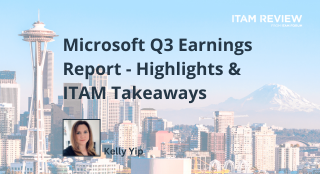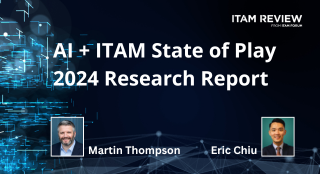IAITAM Preview: A pragmatic approach to SAM

Diederik Van der Sijpe
Ahead of the IAITAM Spring Conference taking place in Las Vegas, April 28 – May 1, I interviewed Diederik Van der Sijpe, Director at Deloitte, about his presentation “A pragmatic approach to SAM”.
In just a few words, tell us what it is you do. What does an average day look like for you?
I’m a director at Deloitte, based out of Belgium. In my day-to-day professional life I’ve focused for over 10 years on software license compliance, software asset management and other intellectual property related services. I’m part of a global team with hundreds of license compliance and SAM specialists. I’m the team lead in Belgian (+/- 45 members) but I also have an EMEA and global role as coordinator of our license compliance and SAM services.
Your session at the IAITAM conference is going be looking at taking a pragmatic approach to SAM. What do you think the first steps should be when implementing a SAM program?
When I talk to customers, the conversations on SAM move quickly into the direction of realizing cost efficiencies and mitigating financial, IT security and other risks. Often organizations are surprised when I tell them that they already have a lot of information available that could help them in taking their initial steps into SAM. The first step in my opinion is deciding upon your SAM aspirations, check what is already in place, which you can leverage upon (e.g. inventories, change management process, etc.) but foremost, realize it will be a journey of continuous improvement.
What are some of the mistakes to avoid when implementing a SAM program?
I come across two common mistakes very often. Companies that are looking for quick fix, typically roll out a SAM tool, which they think will be a silver bullet. Although there are very good tools on the market, one should realize that it’s the combination of the right tooling, processes and, last but not least, people that provides you with a chance on success.
The second mistake is definitely trying to do everything at once. Many organizations have already tried to roll out SAM several times without any success. In fact, they have burned a lot of budget without any visible results and then management shuts down their program. As I said before, implementing SAM is a journey and one should break it up in pieces to get one’s arms around it. A well thought through SAM implementation roadmap is indispensable. The ISO 19770-1 standard can help in formulating one. I especially like the attention it gives to all the processes interfacing with SAM. It clearly shows that the whole organization should support the SAM implementation and vice versa.
What about an organization that already has a SAM program in place but it’s over complex and cumbersome. How do they bring it back on track?
Always go back to the basics. Determine which sources provide you with trustworthy data and re-build your model from there.
I have seen companies that started out fine but after a while, the fine tuning of their SAM processes and procedures made them end up in administrative chaos. With some it seemed easier to order a fighter jet than a piece of software, so to speak. Yes, you can implement financial chargeback. Yes, you can fully automate approval flows. Yes, you can rationalize your software stack to the bare minimum, but keep it simple!
Can a successful SAM program enable “quick wins”? If yes, can you provide examples?
It surely can! Everyone has probably heard stories about typical desktop software that is rolled out across the whole user base because it’s part of the standard build. One can easily realize savings on that. However, there are also possibilities of a quick return in vetting invoices and checking whether the invoice amounts add up to what you have ordered. Did you think about controlling access via LDAP or AD software that is licensed on a per user basis (if it’s allowed to do so)? Checking for more favorable license metrics is a nice one as well, as we do notice that plenty of companies buy or renew their licenses without sufficient scrutiny. There are tons of tips and tricks to optimize software usage/deployment and licensing, but it’s important to note that it’s not a one-size-fits-all principle. What works in one company is not necessarily a good option for another.
If you could only give one piece of advice when it comes to SAM what would it be?
Take one step at the time and do not try to change the world in one day.
What is the most important lesson you have ever learned when it comes to ITAM?
I could talk about all the interesting ITAM solutions I have come across throughout my career but the number one lesson for me is that the ‘outside world’ does not realize how complex ITAM is and how many facets of an organization are actually touched by it. By the way, that is definitely what I like about IAITAM as an organization. They cater for their community to look at ITAM from all different angles possible.
Any final pieces of advice?
Stay passionate about ITAM, spread the ITAM gospel and attend my presentation. Sometimes life can be simple.
Can’t find what you’re looking for?
More from ITAM News & Analysis
-
How ISO/IEC 19770-1 Can Help Meet FFIEC Requirements
In the world of ITAM, the regulatory spotlight continues to intensify, especially for financial institutions facing increasing scrutiny from regulatory bodies due to the growing importance of IT in operational resilience, service delivery, and risk management. ... -
Microsoft Q3 Soars as AI and Azure Growth Fuels Market Gains
On the 30th April, Microsoft released its Q3 quarterly earnings report, exceeding expectations and igniting investor optimism. Investors had been keeping a watchful eye on Azure’s Cloud performance after Microsoft’s Q2 Cloud results fell short of ... -
AI and ITAM: State of Play 2024 Research Report
In 2024, the ITAM Forum and General Interfaces conducted a global survey (On behalf of the ITAM Forum’s AI+ITAM Working Group) targeting ITAM practitioners, executives, and stakeholders to explore the growing influence of AI on the ...
Podcast
ITAM training
Similar Posts
-
How ISO/IEC 19770-1 Can Help Meet FFIEC Requirements
In the world of ITAM, the regulatory spotlight continues to intensify, especially for financial institutions facing increasing scrutiny from regulatory bodies due to the growing importance of IT in operational resilience, service delivery, and risk management. ... -
Microsoft Q3 Soars as AI and Azure Growth Fuels Market Gains
On the 30th April, Microsoft released its Q3 quarterly earnings report, exceeding expectations and igniting investor optimism. Investors had been keeping a watchful eye on Azure’s Cloud performance after Microsoft’s Q2 Cloud results fell short of ... -
AI and ITAM: State of Play 2024 Research Report
In 2024, the ITAM Forum and General Interfaces conducted a global survey (On behalf of the ITAM Forum’s AI+ITAM Working Group) targeting ITAM practitioners, executives, and stakeholders to explore the growing influence of AI on the ... -
We're FinOps. We're Coming for You.
The FinOps Foundation’s recent release of the 2025 FinOps Framework expands its focus beyond public cloud services to encompass a broader spectrum of technology expenditures, including Software-as-a-Service (SaaS) applications and on-premises data centres. This strategic shift, ...




